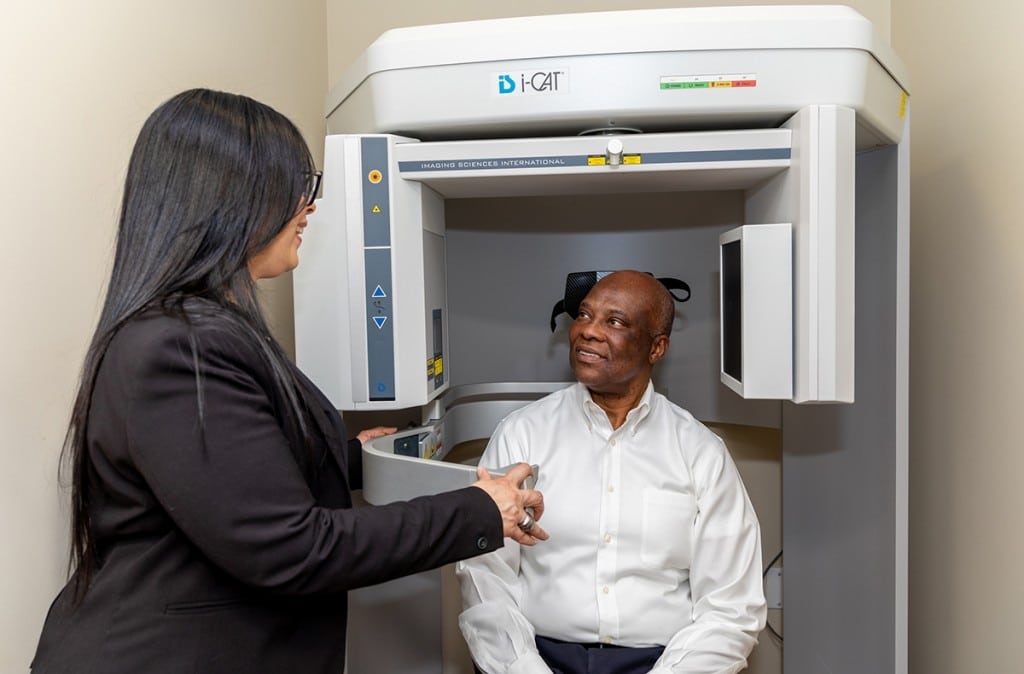A Common Cause of TMJ
In order to understand why phase 2 treatment can give a permanent solution, essentially a cure TMJ, you have to understand what might be causing your TMJ. One common source of TMJ problems is when your jaw system is out of balance. There’s a mismatch among the different components of the system: the teeth, joints, bones, and muscles.
When this mismatch happens, your teeth, bones, and joints prevent your muscles from reaching a comfortable resting position. Instead of resting comfortably, your muscles are working, striving to find that proper position, which puts them in competition with the hard tissues, the teeth, bones, and joints. As your muscles pull on your jaw, it creates clenching and grinding (bruxism) that can damage your teeth, bones, and joints. It can cause nerve pinching and press excessively on the temporal bone, which houses your ear. In short, this imbalance can cause the full range of TMJ symptoms, and they’re only likely to get worse over time.
However, if Westchester County TMJ dentist Dr. Mejia can put the elements of your bite system into a balanced relationship, the tension stops. Your muscles relax. Your teeth stop grinding. Your joint stops getting compressed. Nerves and bones get free from pressure. Your symptoms resolve.

The Phase 1 Treatment Process
Permanently resolving your TMJ symptoms starts with temporarily resolving your TMJ symptoms. When you visit Westchester TMJ & Aesthetics for a diagnosis, Dr. Mejia will take measurements of your jaw system. She will track the movement of your jaw, measure the tension in your jaw muscles, and listen to the sounds of your jaw joint. She will also take real-time measurements of how much force your bite is putting on each tooth. This gives Dr. Mejia a good idea of what’s wrong with your bite.
Next, we will use transcutaneous electrical nerve stimulation (TENS) to relax your jaw muscles. This also resets them, erasing any unhealthy accommodation that your muscles have acquired over the years they’ve been battling the other parts of your jaw system. Then Dr. Mejia will take new measurements, charting the movement of your jaw and the tension in your muscles. This will let her determine the natural point of maximum relaxation for your jaw. Then she will get a custom orthotic (also called a bite splint) that you can wear to hold your jaw in its natural relaxed position.
Now we wait and gauge how well the orthotic is working. TENS provides some immediate relief, but over the next few weeks, other symptoms will improve and potentially disappear entirely. Depending on how well it’s working, Dr. Mejia might adjust the orthotic to improve the quality of your results. Once you and Dr. Mejia agree that you’ve achieved good results–and they’re not likely to get better–you can discuss whether or not to move on to phase 2.
Phase 2 Treatment Helps With Permanent Solution
In phase 2 TMJ treatment, Westchester TMJ dentist Dr. Mejia creates tooth restorations to take the place of your orthotic. Instead of wearing an orthotic, your teeth will hold your jaw in a healthy resting position, alleviating your TMJ symptoms for as long as your restorations last. With proper design and installation of restorations, this can easily mean decades of relief with no further treatment required.
The process isn’t reversible, so it’s important to make sure that you’re ready to go forward with it. This means ensuring you’ve gotten good results with your orthotic, your results are stable, and you’re committed to making a permanent change.
Benefits of Phase 2 Treatment
There are many reasons people choose to get phase 2 TMJ treatment, including:
- Long-lasting TMJ relief
- No need to wear an orthotic
- Repair to damaged teeth
- Replacement of lost teeth
- Achieving a beautiful smile
- Long-lasting TMJ relief
- No need to wear an orthotic
- Repair to damaged teeth
- Replacement of lost teeth
- Achieving a beautiful smile
As we noted above, the results of phase 2 treatment are very long-lasting. Properly fitted restorations in a balanced bite can last decades. You’ll enjoy freedom from TMJ symptoms and won’t need additional treatment until the restorations suffer damage or loss.
In addition, you won’t have to wear an orthotic to keep your TMJ symptoms at bay. This is especially valuable for people who still have to wear their orthotic 24 hours a day to control TMJ symptoms.
Phase 2 treatment also repairs damaged teeth. Many people with this type of TMJ have teeth that are badly ground down and might be chipped or cracked. This isn’t just a cosmetic or functional problem, it can result in chronic tooth pain. With phase 2 treatment, these teeth can be protected and repaired so they don’t hurt anymore.
People often lose teeth due to grinding, and this can make them self-conscious of their smile and make it hard to eat. As part of phase 2 treatment, we will replace most or all lost teeth (depending on what is best for your bite–sometimes back teeth aren’t all necessary, might be expensive to replace, and might even interfere with a healthy bite).
Finally, the restorations Dr. Mejia uses are attractive and natural in appearance. If you’re considering cosmetic dentistry anyway, this is a great way to double the value of your investment: eliminate bite problems at the same time as achieving your beautiful smile.
Want Permanent TMJ Relief in Westchester County
Are you tired of temporary TMJ treatments you have to renew or replace every few months? Do you want a solution that will beautify your smile as well as cure your TMJ? If so, then phase 2 treatment might be right for you.
Please call (914) 594-6854 or use our online form to request an appointment at Westchester TMJ & Aesthetics in Mohegan Lake, NY.
